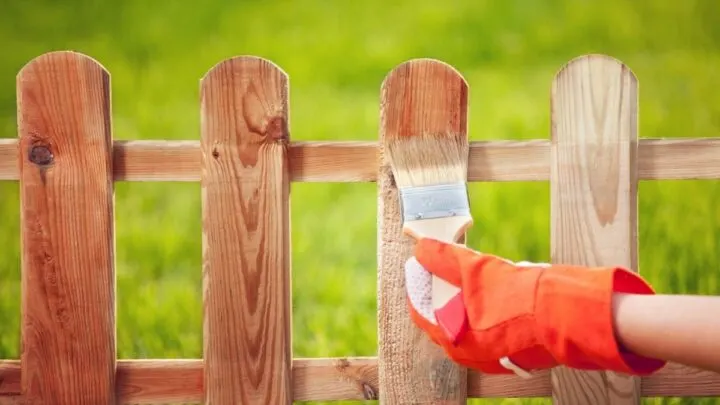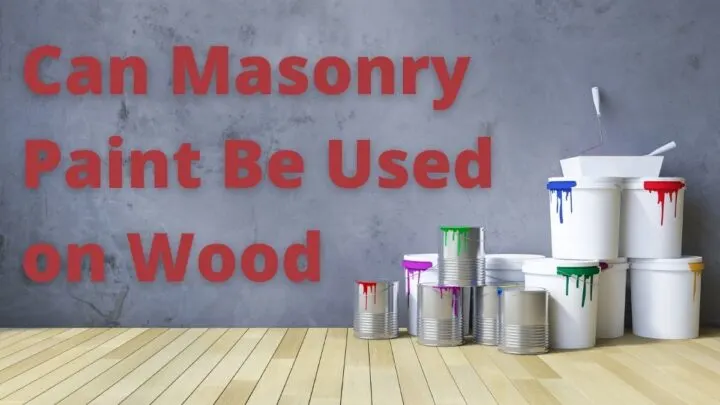Do you want to protect your home’s wooden materials while also giving them a polished appearance?
Well, then masonry paints are what you need.
Masonry paints are acrylic paints that can be used on a variety of surfaces. They are made to stick to even on rough and tough surfaces.
Masonry paint can be applied on wood, concrete, plastics, and even metals. It’s crafted to stick to a variety of surfaces.
The sole purpose of these paints is to enhance the look of the materials used in the construction of a home.
However, they do also insulate the home, add ornamental features, and protect the walls.
To know more about these paints being used on wood, keep reading as we will cover all aspects of this topic in this article.
Should I Paint Wood With Masonry Paint?
As wood is a porous material, the question of whether masonry coatings can be applied to them arises.
You can use masonry paints on wooden surfaces like weatherboards, cladding, and wooden fences.
Painting these wooden objects with masonry paints will not only enhance their looks but will also add an extra layer of protection and insulation to them.
However, you should exercise caution when applying the paint because it can be a difficult task to do.
If applied correctly, it can provide great protection and increase the lifespan of the surface you’re applying it to.
How to Paint Wood With Masonry Paint
Now that you know whether you should paint your wooden objects or not with masonry paints, the next question that arises is how to paint correctly.
If you are planning to paint your woods with masonry paint, follow the instructions outlined below to prevent it from getting a flaky appearance.
- First, you have to prepare the wood surface and the paint to get the perfect results.
- Sand the surface smooth to avoid flaky surface and cracks.
- Do not directly apply the paint to the woods – always apply primer before you start painting to prepare the wood.
- Let the wood get completely dry. Painting is more accurate when done on dry woods or dry environment.
- Now you can paint!
Does Masonry Paint Aid With Home Insulation?
Masonry paint on wood improves the overall insulation of the building.
To get the best benefit from it, make sure you are applying it to every nook and corner so that no parts are left uncovered.
Untreated walls are permeable, meaning they are the weak points in the home.
This permeability makes it prone to absorbing water and moisture. As a result, the walls are not insulated, and the house becomes wet and cold.
If you use masonry paint on woods and other porous surfaces in the home, it offers insulation and will protect the porous quality of the material.
The paint protects the exterior walls, yet it still allows them to breathe and move.
The walls are insulated, but they are still capable of contracting and expanding as needed.
Other than that, masonry paints help to keep the weather out of your home and keep the heat or air conditioning inside.
It will also eliminate the cold spots and drafts when applied to the whole exterior.

How Can I Paint My Wooden Fence With Masonry Paint?
The first thing you need to do before applying the paint is to clean the fence properly.
Remove the old paint and sand it to have a smooth finished surface.
It is advised to use Centrecoat GS36 for a moss-free surface. It is great for getting rid of organic contaminants like lichen, algae, moss, and mold.
In addition to destroying the infestation, it will also help to prevent regrowth while extending the life of the paint.
Masonry paints are quite thick and you will not find it easy to paint fences with them.
Because of its thickness, you will be needing fewer layers of masonry paint giving you a finished look in just 2 layers.
It adheres to the wood effectively and gives a clean and crisp finish.
When you use a fungicidal wash, dilute it with water in the ratio of 1:20 and then apply it.
When you are done with the mixture, simply wet the area with a fungicidal wash and allow it to get dry.
Once the fences are dried, it’s time for you to start painting. Try not to paint on hot and bright days, specifically when it is windy.
This causes the paint to dry too quickly, failing to absorb into the wood.
Conclusion to Masonry Paint Being Used on Wood
Hopefully, after reading our article, most of your queries about the masonry paints on wooden surfaces have been covered.
The main outcome is, that you should not directly apply the paint on the wooden surface, instead apply a primer for the best results.
Moreover, make sure to apply it when the weather is right. Happy painting to you all!


